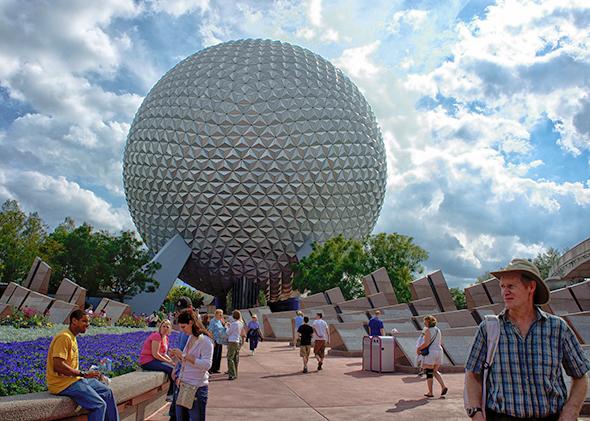I grew up at Disney World.
Or, more accurately, I grew up just outside of Orlando—which means going to theme parks fell into a category closer to routine trips to the mall than once in a lifetime family vacations. In any case, I went a lot. And as Florida’s questionable history suggests, regular exposure to parades, polyester-dressed princesses, and price-gauged soft drinks inevitably warps one’s perspective on life. Through the lens of Disney, a child’s expectations tend to veer about a hundred degrees too saccharine. Everything at Disney World is appealingly safe and familiar, with just a hint of whimsy and novelty—especially the food.
And yet it was Disney World—specifically, Epcot—that taught me to love trying new foods.
I learned early on that while Epcot’s rides are nothing to write home about—the stultifying troll ride hasn’t been updated since the eighties—it’s the only place in the park where you can get a Norwegian cream horn. And there’s no reason to stop there. By visiting the eleven countries represented in the World Showcase area of the park—Mexico, Norway, China, Germany, Italy, Japan, Morocco, the United States, France, the United Kingdom, and Canada—guests can “taste [their] way around the world.” A spin though France promises custardy, flaky Napoleon. Drop by the United Kingdom, and you can come away with fish and chips wrapped in oil-spotted newspaper. Not all the vendors strive to serve you something new: At the tiny, confused Africa outpost, a smiling man from Nigeria will sell you a hot dog and a chocolate chip cookie.
Apart from Taco Bell, this global tour of gluttony was my first real experience with international food. Instead of the generic chicken fingers and pink-frosted cupcakes I inhaled at Magic Kingdom, at Epcot I savored crêpes stuffed with roast chicken and béchamel, cannoli with candied lemon, and sweet potato tempura. These dishes were by no means wholly authentic. (The crêpes were not buckwheat. The cannoli cream was chocolate-flavored.) But I liked them. A lot. And they taught me that there were many delicious things in the world to be eaten.
Since then, I’ve visited quite a few of the Epcot countries for real, far away from Florida soil. I started by taking baby steps away from American food: There was a family vacation to London when I was in middle school, then a school trip to Paris, which I spent searching unsuccessfully for the ham and cheese croissant that Epcot France had promised me.
At first, I had a tendency to subconsciously judge the local food based on what I now like to refer to as the Epcot test: How does it compare to its Disney-fied counterpart, and how well does it meet my Disney-fied expectations? China, as one of my first big destinations, failed miserably. Turns out it’s not all deep-fried eggrolls and fluorescent orange chicken over there. Unprepared, I struggled to choose something that I recognized from Epcot on restaurant menus laden with descriptions of chicken feet and chili beef. Needless to say, I ended up eating a lot of rice.
Despite these initial hiccups, the overall lack of authenticity at Epcot didn’t impede my growing appreciation for international cuisines. Travel pushed me to expand my palate. As I let go of my childhood expectations, I learned that taking a risk on something unfamiliar could yield great gustatory reward. Soon, I found new benchmarks, standards, and food memories while devouring the real deal. Veal goulash in Berlin was so rich and syrupy it was more molasses than stew. The asparagus gelato I tracked down in Venice—surprising, cool, refreshing—provided a welcome break from thickly sweet caramels and chocolates. I’ll never forget snacking on fried cheese sandwiched between brioches in Prague. It tasted so familiar, like late nights studying at a college diner with friends, and still so foreign.
I recently went back to Epcot for the first time in five years. Lots of adults who’ve traveled internationally might be inclined to criticize Disney for its lack of authenticity, to reject its dishes in favor of “purer” versions of the same thing. But instead, after eating a lot and then eating some more, I realized that Epcot’s lack of authenticity helped develop my curiosity about international food. Epcot gave me a starting place and a point of comparison. For example, their dumbed-down version of tacos, the blandest iteration possible of ground beef and cheddar cheese, made an unfamiliar meal just familiar enough for me to try—a step toward the lamb barbacoa and rajas I love today.
In turn, traveling internationally also increased my appreciation for Epcot. Not all of Epcot’s offerings are so basic or predictable: Its Moroccan baklava is an exact copy of the kind I sampled in Turkey (except for the resinous, otherworldly honey that drove me to carry boxes of the real thing home). And its kakigōri with condensed milk could pass for the original Japanese version.
Still, my recent trip to Epcot reminded me of one thing I’ve slowly come to understand since I first chowed down on fried bread in Epcot Canada: that authenticity isn’t required to enjoy a meal. In fact, some things are better when they’re unauthentic—I will always defend the genius of the underappreciated ham and cheese croissant, which Epcot France does very well. From red sauce Italian-American classics to the beloved Chinese-Cuban restaurant by my old apartment, authenticity is irrelevant if the meal is well prepared, hot, and eaten in good company.
I have been lucky to share many wonderful meals under many circumstances in many different countries. But there’s one memory I’m especially fond of: My boyfriend and I are sitting by a lake, dipping warm, salty tortilla chips into fresh guacamole, laughing at the birds staking out our leftovers—at Epcot.
